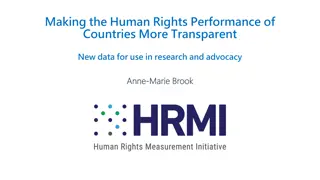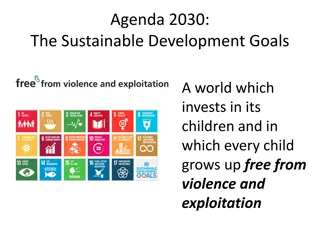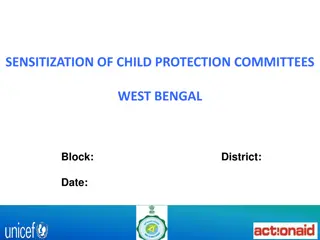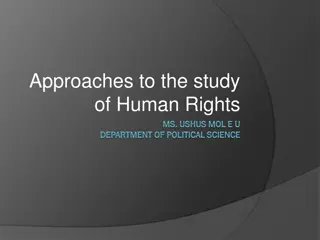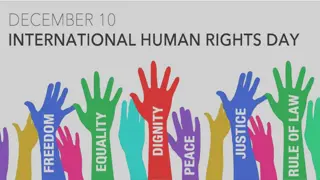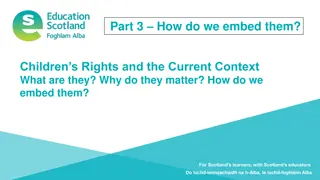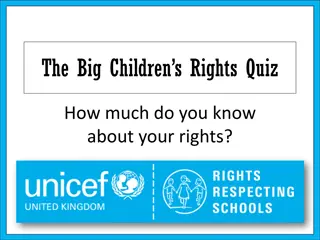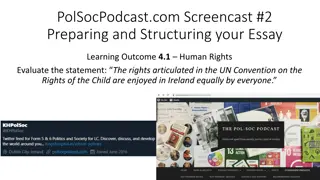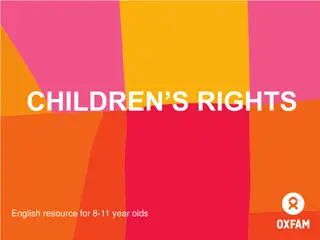Rights of the Child to a Healthy & Sustainable Environment
The importance of protecting the rights of children to a healthy and sustainable environment, considering climate change impacts, environmental hazards, and the vulnerability they face. Learn about the Convention on the Rights of the Child and how children can become agents of change in their communities.
- child rights
- healthy environment
- sustainable environment
- climate change impacts
- environmental hazards
- vulnerable children
Download Presentation

Please find below an Image/Link to download the presentation.
The content on the website is provided AS IS for your information and personal use only. It may not be sold, licensed, or shared on other websites without obtaining consent from the author. Download presentation by click this link. If you encounter any issues during the download, it is possible that the publisher has removed the file from their server.
E N D
Presentation Transcript
Rights of the Child to a Healthy & Sustainable Environment UNICEF | KWM 22 October 2019
Why Children? Physiologically developing and hence face more dangers both physically and cognitively to extreme weather and environmental factors More vulnerable to diseases and illnesses due to under-developed immune systems They face greater dangers from undernutrition and diarrhoeal diseases Socially and economically dependent on adults Will bear the brunt of climate change far longer than adults Not just victims but can also be agents of change in their communities Poor children are especially vulnerable Convention on the Rights of the Child Articles on survival and development, health (including considering environmental pollution risks), adequate standard of living, education 2
Climate Change Impacts on Children Droughts and Water Stress Floods and Severe Storms Heat Stress Diseases 3
Environmental Impacts on Children Waste Pesticides Air Pollution Deforestation 4
What Are The Main Climate Risks for our Region? Morbidity and mortality from climate-sensitive diseases Temperature rise of about 0.5 2 C by 2030 and 1 7 C by 2070 Sea Level Rise, 10-20% > global mean by 2100 Saltwater intrusion Flooding Crop yields, from 5-30% by 2050 relative to 1990 levels with risks of hunger 10% of rainfall by 2050, seriously compromising freshwater resources Significant loss of coral reefs and mangroves, with knock-on effects on commercial fishing and artisanal fisheries 5
Floods and Severe Storms More than half a billion children live in extremely high flood occurrence zones, the vast majority of them live in Asia Floods threaten children s survival and development. Direct impacts include injuries and death by drowning Indirectly, floods pose a grave risk to children s health. Floods compromise safe water supplies, increasing the risk of diarrhoea outbreaks. They also damage sanitation facilities, contributing to water contamination and undermining the sustainability of sanitation behaviours 6
East Asia Pacific -1/3 of Global CO2 emissions CO2 per capita (2013) Viet Nam Timor Leste Thailand PNG Philippines Pacific (Fiji) Myanmar Mongolia Malaysia Lao PDR Indonesia DPRK China Cambodia 0 5 10 15 7
Air Pollution Nearly 1 in 10 under-5 deaths is linked to air pollution In South-east Asia and Western Pacific, more than 150,000 and 55,000 under-5 deaths due to indoor and outdoor air pollution respectively in 2012 Leading risk factor for child deaths in many countries Globally, 7 million deaths are attributed to air pollution in 2016 Source: WHO 2012, UNICEF 2016 8
Country Climate Risk Index Rank Fatalities/ annual average Fatalities per 100,000 Losses in US$ Millions (Annual Average) Losses per unit GDP Myanmar 3 7 048.850 14.392 1 275.961 0.661 Philippines 5 867.400 0.971 2 932.153 0.576 Viet Nam 9 296.400 0.350 2 064.740 0.516 Thailand 13 137.800 0.209 7 894.763 0.936 Cambodia 19 53.300 0.384 242.493 0.723 Fiji 20 7 0.837 119.983 1.896 China 37 1 240.800 0.094 36 601.070 0.288 Mongolia 62 6.900 0.259 82.338 0.307 Indonesia 69 252.000 0.109 1 798.562 0.083 Lao PDR 89 6.300 0.108 73.910 0.237 Papua New Guinea 95 18.250 0.285 15.065 0.076 Malaysia 116 21.450 0.078 182.228 0.033 Timor-Leste 177 0.100 0.010 0.266 0.004 9 Global Climate Risk Index 2019 (for 1998-2017 period)
Impact on education Indonesia example Over past 15 years 49,118 schools affected by disasters 10
UNICEFs Focus Areas REDUCE EMISSIONS AND POLLUTION MAKE CHILDREN THE FOCUS OF ENVIRONMENTAL STRATEGIES PROTECT CHILDREN FROM IMPACTS EMPOWER CHILDREN TO BE AGENTS OF CHANGE 11
Examples of a Results Framework of theUNICEF East Asia Regional Climate Change Action Plan 2020-2023 (to be updated 2022) Output Outcome 1: Climate resilience of children, especially, most vulnerable children is enhanced through child-sensitive climate resilient solutions packages Output Indicators # of countries with climate risk management plans for WASH # of communities with climate resilient water supply systems in # of countries # of children with improved drinking water services in # of drought-prone areas in # of countries 1.1. Climate resilient WASH # of countries with climate vulnerability assessments for child health # of countries tracking children s environmental health # of local health centers with climate risk assessments and measures # of children benefiting from enhanced vector control measures in # climate hotspots for vector-borne diseases 1.2. Climate resilient Health # of countries with climate vulnerability assessment for education, integrating climate data into EMIS and education planning and budgeting # of schools with climate adaptation and eco-school initiatives # of children benefiting from alternative climate resilient learning modalities in # climate hotspot countries 1.3. Climate resilient Education # of countries with nutrition-sensitive climate mitigation and adaptation plans # of children receiving climate smart nutrition services 1.4. Climate resilient Nutrition # of countries with adaptive social protection schemes, child poverty analysis # of children receiving social protection support that explicitly addresses climate adaptation needs 1.5. Adaptive Social Protection 12
Examples of a Results Framework of theUNICEF East Asia Regional Climate Change Action Plan 2020-2023 (to be updated 2022) Output Indicators Output Outcome 2: Greenhouse gas emissions are limited through child-sensitive climate smart solutions # of children benefiting from schools with improved access to clean, affordable and reliable modern energy # of children benefiting from health care centers with access to clean, affordable and reliable modern energy # of communities with clean and affordable technologies and fuel for cooking and heating 2.1. Decentralized clean energy services # of urban areas with child-sensitive air quality monitoring systems # of urban areas with child-sensitive clean air plans # of children participating in air quality monitoring # of children participating in clean air solutions 2.2. Clean air solutions Outcome 3: Children s needs and perspectives are integrated into national policies and investments related to climate change 3.1. Child-sensitive climate change policies and plans # of countries and local governments with child-sensitive climate change policies and plans 3.2. Public finance for child- sensitive climate change # of countries with tracking climate change budget for children # of countries and local governments with budget allocation for child-sensitive climate actions # of children and youth groups participating in climate change policy making and investment decision- making # of children and youth groups participating in design and implementation of climate solutions 3.3. Youth participation mechanisms 13
Laws relating to child rights 14 King & Wood Mallesons / www.kwm.com
Laws since 1989 15 King & Wood Mallesons / www.kwm.com
Overview of Existing Laws in Five Countries 16 King & Wood Mallesons / www.kwm.com
Overview of Existing Laws in Five Countries 17 King & Wood Mallesons / www.kwm.com
Recommendations 1. Effective implementation and enforcement of laws 2. Raise government, business and public awareness 3. Require businesses to comply with human rights principles 4. Collaboration between countries on a follow-up project on guiding principles 5. Integrate child s rights into existing environmental impact assessments 6. Collaboration between neighbouring states in preventing transboundary harms 7. Implement existing special rapporteur report recommendations 8. Encourage a multi-sectoral approach from human rights bodies 18 King & Wood Mallesons / www.kwm.com
Thank you 20








